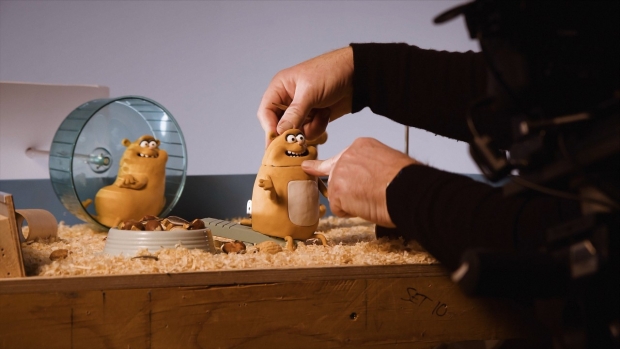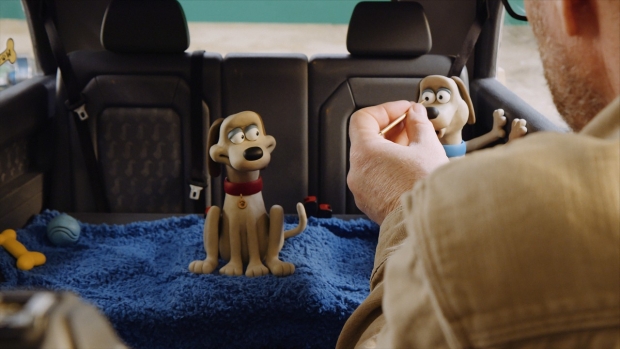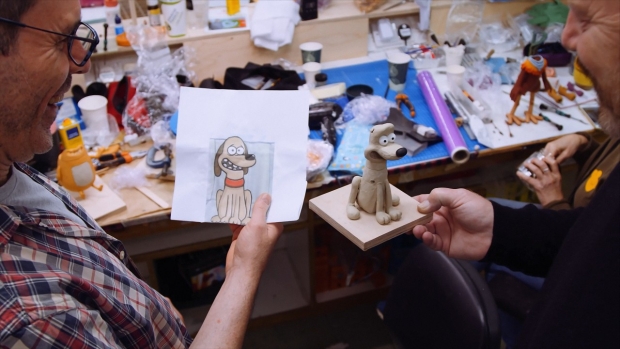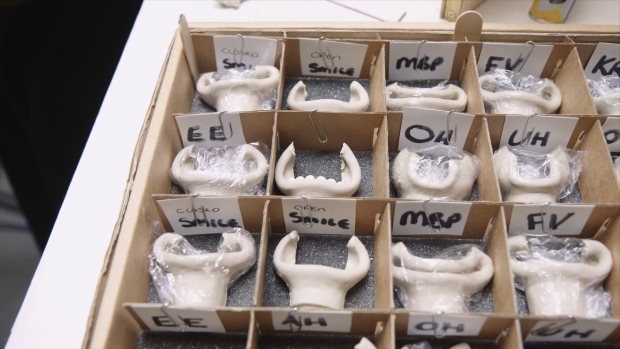The UK broadcaster's new promotional series, paying homage to the famed ‘Creature Comforts’ franchise, transforms viewers' favorite programs into animated shorts using the iconic studio's celebrated mix of humor and stop-motion.
For decades, Aardman has been creating stop-motion creatures full of nuance, humor, and wit. And their most recent partnership with the British Broadcasting Corporation (BBC) brings together two of the things they do best: humor and charmingly toothy Claymation.
“Aardman’s had an ongoing relationship with the BBC for a long time,” notes Rich Webber, the director behind Aardman’s latest series of animated shorts, Things We Love, now on their YouTube channel. “We’ve done quite a lot of stuff together. So, when they approached us to see if we could do a Creature Comforts style piece, where we’d go out and interview the British public about the programs they love on the BBC, we thought it was a great idea.”
Like this!
Creature Comforts is a wonderfully inventive adult stop-motion comedy mockumentary franchise created by Nick Park and Aardman Animations. It originated with Park and Aardman’s hilarious, Oscar-winning 1989 animated short film of the same name, which matched animated zoo animals with voices of people talking about their homes, making it appear as if the animals were being interviewed about their living conditions. The film later became the basis of a series of television advertisements for electricity boards in the United Kingdom, and in 2003, a television series in the same style was released.
“Things We Love is similar in that there was no script, so you don't know exactly where you're going with the short until you start to interview people,” shares Webber. “We got some lovely warmth, comedy, and natural conversation. We started with only a few questions and then let the conversation go where it wanted to go, keeping an ear out for possible animated scenarios or animals that would be a good fit for conveying what’s being said and who’s saying it.”
Aardman has created six short films in total for the BBC's Things We Love campaign, transforming the interviewees into Claymation animals, from pigeons to hamsters. Five of the six shorts are currently released. The sixth and final short – which centers on an older and younger brother as mice – releases Saturday, April 6.
You can watch all the released shorts here.
BBC sourced the interviews while Aardman met people in their homes, hoping to keep interviewees as relaxed as possible to make for more organic animations. In the second of the six shorts, a family from Birmingham who can’t get enough of MasterChef is portrayed as foxes, rummaging through waste bins. Two of the five foxes, hanging out in dumpsters in the back, banter about the possibility of the other’s success on the show if he were to ever contend. One declares between laughs, “You would do terrible on MasterChef.” The second fox reaches into the bin and pulls out a crudely made salad, flies buzzing about, waiting for approval. Another member of the fox family replies simply with, “Questionable.”
“We're always listening for those little things, those pauses while someone is thinking about the next thing they're going to say,” says Webber. “It makes it all more relatable.”
One of Webber’s favorite shorts is the third in the series, which features a father and son from Paisley – near Glasgow – as a canine duo talking about their mutual love of Race Across The World.
“They are Indian Glaswegians, so their accents are fantastic,” notes Webber. “And there's a real warmth between them. They talked about how the program bonds them, and it was just really lovely. At the end, they kind of look at each other and agree. And it was just really sweet.”
The malleability of stop-motion lends itself well to moments like these, where the expressions are all in the eyes, or where interviewees laugh at themselves, or family interjects from the background.
“All of our characters are very expressive, so we molded quite a large brow structure for each of them, with heavy eyelids as well,” says Webber. “The mouths are built to be replaced frame by frame based on the phonetics. But, because it's plasticine, you can continue to mold the mouth and get in those little nuances, the oohs and ahhs. You can relax the mouth a little bit or preempt it when it's going to speak.”
He adds, “And we try to keep all the little indents in there so you can see where an animator has touched it. It gives it a much more living feel.”
In addition to letting fingerprints shine on camera, Aardman also has been releasing behind-the-scenes videos on their social media with the release of each new short. Featurette videos show time-lapses of the model molding and moving process on set.
Because the videos would be published on social, as well as on Aardman’s YouTube channel and the BBC network, Webber says the team had the extra challenge of framing their shorts for three different styles of video.
“We’ve done a few things like this with Shaun the Sheep, and you have to think doubly hard about where you're framing,” notes Webber. “God forbid you have another character in the background walking off the screen.”
This was a particular consideration in the first short, where, more distinctly than in the other videos, the characters are not in the same depth of field. A family from Port Talbot in Wales are portrayed as wired hamsters – one in the foreground doing most of the talking, another lounging on a background wheel and the other stuck in a toilet paper roll – discussing BBC’s medical drama Casualty and one hamster’s affinity for murder shows.
“The mother in that one, the one on the wheel, came out with some great expressions, like when she refers to the fake blood on Casualty as ‘joking blood,’” says Webber. “She was lovely. And it’s not us trying to be mean, emphasizing those word stumbles. It’s a beautifully natural thing we actually really enjoy animating. And it feels great when you find those moments in the interviews.”
Webber hasn’t gotten to meet most of the interviewees himself since the interviews were conducted by others at Aardman, so listening with intent is paramount to making the animations reflect the feelings of those speaking. In the case of the father and son from Paisley, there was a slight variation in the accents between the two generations, indicating that the two were born and raised in different places. It adds to the emotion that comes from their favorite shared show being Race Across the World, and noting that importance in the dogs’ faces with each exchange of eye contact was no easy task.
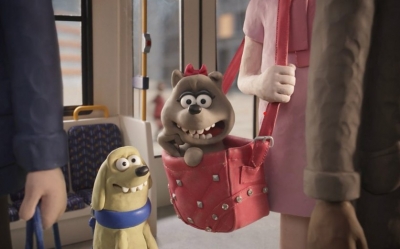 “I’ve gotten to know these people very well, without having met most of them,” says Webber. “There was a lady from Sheffield who was the subject of the short with the dog in the handbag and as she talked about Match of the Day and EastEnders I noticed there was a bit of a lisp and we emphasized that more in the video by making the dog’s top set of teeth rather large. I have no idea if she has teeth like that in real life. Hopefully, it’s not terribly upsetting.”
“I’ve gotten to know these people very well, without having met most of them,” says Webber. “There was a lady from Sheffield who was the subject of the short with the dog in the handbag and as she talked about Match of the Day and EastEnders I noticed there was a bit of a lisp and we emphasized that more in the video by making the dog’s top set of teeth rather large. I have no idea if she has teeth like that in real life. Hopefully, it’s not terribly upsetting.”
Webber did get to meet the Port Talbot family in person and shares they had a good laugh at the hamsters. They were the only interviewees who got to see their animation in advance of release.
“They thought it was so funny and all I could say was, ‘Thank god you like it,’” says Webber. “For my own personal style, I love squash and stretch. We'd never done that in Creature Comforts before, but we got to do it a bit on these shorts. You can really see it when the hamster in the toilet paper roll falls in the background and we stretch his eyes out. We also stretch the eyes a bit with the fox family as the one pops in and out of the bin.”
Though the Things We Love campaign is nearing its end, Webber notes he’d be more than happy to continue the shorts or do more projects like it in the future.
“We’ve gotten to include more moving backgrounds as well on these shorts, which is something we didn’t get to do on Creature Comforts,” shares Webber. “It would be great to do more because they are so evolving and, listening back to stuff, it’s easy to start drawing out characters and thinking of little scenarios we haven’t done yet. Plus, I love sitting there and listening to people talk I don’t know how else I could pick out the golden 30 seconds of an hour-long interview.”
